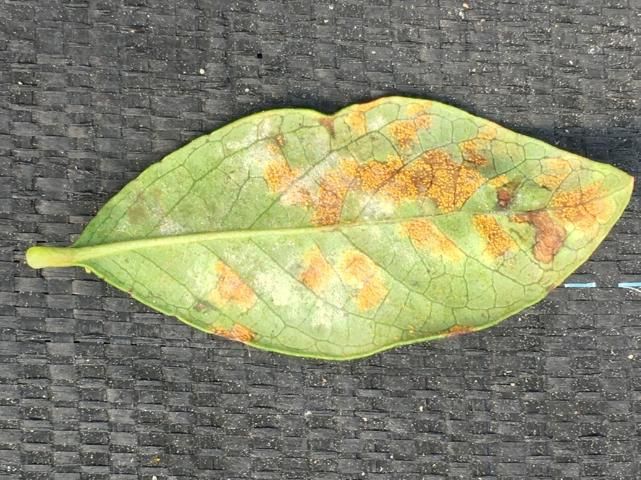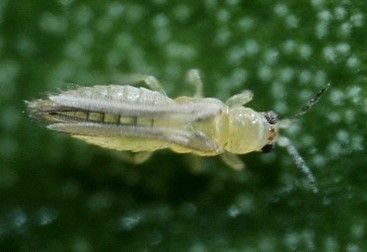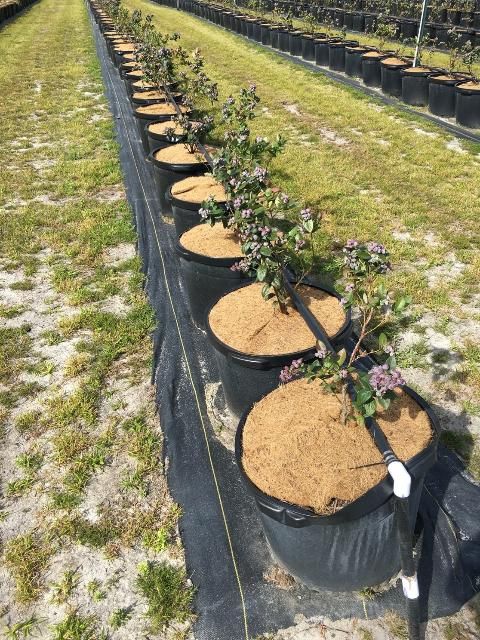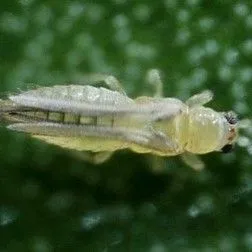Organic Blueberry Production in Florida
Introduction
There is a growing market in the US and globally for fresh fruits and vegetables with reported health-enhancing properties. This includes blueberries, which are high in antioxidants and have been reported to improve heart health and contain anti-cancer properties. In 2019, Florida producers harvested 1.9 million pounds of organic blueberries, about 2.5% of the total US production of 77.5 million pounds. In 2022, sales of organic blueberries totaled $410 million, a 4.1% increase from 2021, and accounted for 17% of the total retail blueberry market. In addition, there is an increasing level of consumer interest in organically grown produce (for environmental conservation, taste, and other perceived benefits), for which some consumers are willing to pay a premium over the price for a conventionally produced crop.
The United States is the largest producer of blueberries globally, as well as a major source of organic blueberries. According to the 2019 USDA Certified Organic Survey, there were 539 organic blueberry farms in the United States (10,300 acres), with 77.5 million pounds sold at a market value of $205.2 million. During the same period in Florida, there were 43 organic blueberry farms with 1.9 million pounds sold. This publication provides an overview of organic production of blueberries in Florida. Any practices or inputs recommended or discussed in this document must be approved by the producer's certifying agency prior to adoption or use.
Organic Certification
Organic production systems generally have higher costs than conventional systems, but the additional costs can often be balanced by price premiums for organic produce. The use of chemical inputs is restricted to naturally-derived pesticides, herbicides, and fertilizer, and growers must use ecological and cultural strategies to manage nutrients and pests. Successful organic blueberry producers recognize it as the production system itself that is certified; the products simply bear the label. In order for produce to be marketed as organic, the production system must be certified under the USDA National Organic Program (NOP) rules. These rules require, among other things, that no prohibited substances be applied to the land for three years immediately prior to the first harvest that will be marketed as organic, as well as in subsequent years. This generally includes most synthetic substances, unless specifically permitted. The Organic Materials Review Institute (OMRI) provides independent reviews under organic standards for fertilizers, sanitizers, pest controls, and other inputs intended for use in certified organic production and publishes compliant products in the OMRI products list (https://www.omri.org/omri-lists). However, not all products listed in OMRI will be allowed by your certification agency, so always check with your certifier first before making any purchases.
The organic certification process begins with selecting an accredited certifying agency, who will work with producers as producers develop a written Organic System Plan (OSP) to describe the soil and pest management strategies and other important features of their production systems, including plans for postharvest handling and processing. An inspector will perform an onsite inspection to ensure producer’s OSP is complete and accurate. For example, an OSP for an organic blueberry producer will include written strategies to manage alleys for weeds, replace unproductive shrubs, document nutrient deficiencies, and protect bees. Along with the OSP, producers provide their records for irrigation, crop production and protection inputs and purchases, the recordkeeping system, and practices and barriers to keep organic and non-organic systems separate. Once certified, the OSP must be updated with each change and provided to the certifier annually to continue certification. Additional details are available in the USDA’s National Organic Program Handbook (https://www.ams.usda.gov/rules-regulations/organic/handbook) and https://edis.ifas.ufl.edu/cv118.
If producers are transitioning from a conventional system, they will be asked to provide management records from the past three years, including all inputs, their rates of application, and copies of labels and invoices. If producers are breaking new ground, they will be asked to provide records of the previous field history.
If producers intend to maintain both conventional and organic acreage, the two systems must be clearly separated at all steps in the production cycle. For example, specialty equipment such as planters and harvesters can be shared between systems, but they must be cleaned according to an approved SOP in the OSP prior to using on certified land. Items that cannot be thoroughly cleaned must be labeled “organic use only.” Storage facilities for inputs and produce must have dedicated, labeled space for organic production.
In the discussion below, we present examples of inputs that can be used in certified systems. Be aware that many products exist with multiple formulations, and that active AND inactive ingredients are evaluated with equal importance to determine compliance. A list of compliant products (by name brand or active ingredient) is available at https://www.OMRI.org. Producers should work closely with their certification agency to confirm approval before applying inputs of any kind to seeds, plants, soil, equipment, or food contact surfaces. Note that input approvals are specific to intent. For each input approval request, producers must describe its intended use (i.e., pest management or crop fertility).
As with the use of any chemical products, note pre-harvest interval (PHI) and re-entry interval (REI) time periods, follow all label instructions, and check with your organic certifier to confirm acceptability for use in an organic system and on specific product formulations.
Sourcing and Selecting Plants
If producers are establishing a new orchard, stock plants should preferably be sourced from a certified organic nursery operation. Organic stock will allow producers to sell the fruit with an organic label in the first year of establishment, provided that the farming system was certified before the new plants were installed. If stock is purchased from a noncertified source, producers must provide evidence that an equivalent organic stock was not available, and they are not allowed to market or label fruit from that plant or the plant itself as organic until 12 months after planting.
Because there are limited management tools for disease and pest control in organic systems, growers should consider planting cultivars that are resistant to some of the more common diseases and pest damage. For information on University of Florida southern highbush blueberry cultivars, see EDIS publication HS1245, Southern Highbush Blueberry Cultivars from the University of Florida (https://edis.ifas.ufl.edu/hs1245), and the UF blueberry breeding program website (https://www.blueberrybreeding.com/varieties). Producers may also want to consider purchasing larger plants to achieve more rapid canopy closure, which can help minimize weed pressure.
Fertilization
Blueberries have shallow, fibrous root systems with no root hairs, so their capacity to take up water and nutrients is limited. In Florida, blueberries are typically planted in pine bark beds on top of the soil, in soil beds amended with pine bark, or in containers with pine bark media. Neither pine bark nor Florida’s sandy soils hold water and nutrients well, requiring modifications to traditional fertilization practices to use lighter, more frequent applications. In mature plants, nutrient demand is highest in the spring during fruit development, and in summer through early fall when rapid canopy growth occurs. See the UF EDIS Publication HS 1356, Nutrition and Fertilization Practices for Southern Highbush Blueberry in Florida (https://edis.ifas.ufl.edu/pdffiles/HS/HS135600.pdf), which includes guidance for detection of nutrient deficiencies and application strategies for fertility inputs. Transitioning and certified producers should be aware the publication includes references to fertility sources that are not approved for use in organic systems.
Crop Fertility Sources
Nitrogen (N)
- Blood meal (12%–13% N)
- Feather meal (12% N)
- Fish meal (10% N)
- Fish emulsion or hydrolysate (2%–5% N)
- Broiler litter (1.4% N)
- Organic cotton seed meal (6% N)
- Chilean nitrate (15% N) (may be restricted in some areas with saltwater intrusion concerns)
Phosphorous (P)
- Bone meal (7%–15% P)
- Rock phosphate (3%–26% available P)
- Blood meal, fish meal, broiler litter, and cottonseed meal also contain some levels of P
Potassium (K)
- Potassium sulfate (50% K)
- Potassium magnesium sulfate (22% K)
- Blood meal, broiler litter, and cottonseed meal also contain some levels of K
It is important to perform foliar analysis tests at least annually to determine whether the current fertilizer program is providing the plants with nutrients at the recommended levels and to adjust the program accordingly. The beds' or containers' pH level should also be tested regularly to ensure that the recommended range of 4.5–5.5 is maintained.
Weed Management
Weed management can be one of the most significant issues in Florida blueberry production in both organic and conventional systems. Weeds compete for water and nutrients, act as alternate hosts for disease pathogens and insect pests, and alter the plant's microclimate. See EDIS publication HS90, Weed Management in Blueberry, for additional information. However, the herbicide products permitted to be used in organic systems are very limited, with moderate and inconsistent effectiveness. Available weed control methods are listed below.
Cultural Controls
- When establishing a new orchard, eliminate established weeds and reduce the weed seed bank with mechanical cultivation, steam, and if necessary, hand removal.
- Removal of perennial weeds prior to planting.
- Planting grasses between rows to minimize weeds within the planting area. Maintaining a living cover in row alleys is preferred over cultivation which can damage roots and facilitate erosion. Maintaining turf or other living cover in alleys reduces radiant heat in spring when high temperatures can reduce fruit set and fruit quality.
- Weed mats made of coconut coir or woven polyethylene landscape fabric can be expensive but are effective in reducing weed germination. This approach may be useful if mechanical cultivation equipment is limited during orchard establishment or transition. Mats and woven mulches should be removed and pine bark mulch used for weed control instead when practical to facilitate soil incorporation of granular fertilizer.
- Apply pine bark mulch to the soil surface. Mulch should be at least 3 inches thick, and should surround the base of each plant 2 feet in all directions (= 4 foot wide strip). Larger nuggets will decompose more slowly, but may allow more light to pass through to the soil surface (and stimulate weed seed germination). Consider applying a layer of smaller nuggets on the soil, and top with larger nuggets. Pine bark from some sources may contain lime which raises soil pH and should not be used for blueberry cultivation if possible. Where lime cannot be avoided entirely, only mined calcitic or dolomitic lime are allowed. Burnt, hydrated, quicklime, basic lime, and slag are prohibited.
- Regularly mowing areas around the field to avoid weed seeds blowing into the production field.
- Use a bag attachment to capture weed seeds when mowing.
- Coconut coir discs for container production.
Non-Synthetic Herbicides
Preemergent
- Corn gluten meal (must meet criteria for GMO use in organic systems)
Postemergent
- AXXE (ammonium nonanoate) (only allowed for farmstead maintenance areas)
- Suppress EC (capric + caprylic acid)
- Vinegar (acetic acid)
- Recent trials by Oregon State University showed excellent weed control with saturated steam and a mechanical weeder with a rotary brush attachment. In addition, effective control was observed with AXXE and Suppress (following a successful initial treatment). Trials in Georgia on rabbiteye blueberry found that organic herbicides did not perform well on grasses.
Disease Management
In Florida’s hot, humid climate, several diseases can be issues in blueberry production, including fungal leaf diseases, fruit rots, stem blight, and parasitic algae. Numerous EDIS publications can be referenced for information on pathogen symptoms, signs, and life cycles. However, these publications include synthetic products that are prohibited in organic systems as well as cultural and chemical options that may be suitable for organic production. Samples of plant tissue with disease symptoms can be sent to the UF/IFAS Plant Diagnostic Center for analysis and diagnosis (https://plantpath.ifas.ufl.edu/extension/plant-diagnostic-center/).

Credit: D. Phillips, UF/IFAS
In order for infectious plant disease to occur, there must be (1) an active pathogen, (2) a susceptible plant host, and (3) environmental conditions that are favorable for infection. Removing any of these three conditions through control measures can be successful in reducing the incidence of disease. Producers are must demonstrate an integrated management system that prioritizes cultural and biological strategies before using approved pesticides. Methods for organic disease control include:
Cultural Controls
- Select using cultivars that are known to be resistant to (or tolerant of) more prevalent diseases or are not known to be overly susceptible to certain diseases.
- Carefully consider site selection for new fields. In particular, avoid planting blueberries in very wet areas, because these areas could increase the possibility of developing Phytophthora root rot. Also, ensure good drainage by using raised beds, drains, or both to minimize root rots.
- Avoid bringing disease into the field—start with disease-free planting materials, consider using approved sanitizing products on recycled surface water irrigation systems, avoid reusing bark from certified fields or container systems, disinfect containers before reusing, disinfect pruning equipment frequently, and clean and disinfect other equipment (including tractors and implements) before moving between fields.
- Consider using drip or microjet irrigation instead of overhead to minimize the spread of water-transferred pathogens and reduce leaf wetness duration, or time overhead irrigation to minimize leaf wetness periods.
- Prune out and destroy diseased canes and open the plant canopy for increased air flow. Remove and destroy fallen twigs and leaf litter to remove inoculum from the field.
- Remove and destroy bacteria-infected plants (e.g., Ralstonia, Xylella).
- Practice good weed control to remove possible alternative hosts for disease pathogens and allow good airflow through plant canopies.
- Avoid plant stress through good general management practices, including proper irrigation, so plants are not drought-stressed or too wet; fertilization, so plants are not lacking any nutrients in advance of need; and maintaining soil/media pH in the recommended range (4.5–5.5) to maximize availability of nutrients. Excessive nitrogen fertilization can result in more succulent leaf growth, which may be more susceptible to some diseases.
- Promptly harvest ripe fruit, and rapidly cool harvested fruit to reduce the occurrence of postharvest fruit rots.
Compliant Disease Control Products
Products can generally be divided into two categories, including general biocides derived from naturally occurring elements and biological products containing live cultures or an organismal by-product.
Among general biocides, copper from a variety of mixtures and reactions (see below) has been the most widely used for plant disease management since Bordeaux mixture was documented by Millardet in 1885 to prevent grape downy mildew. Copper is an essential trace element for plant growth. At higher rates, copper also can provide excellent efficacy for primarily foliar diseases caused by fungi, water molds, and bacteria, with limited data available on algal disease management. Copper is only effective as a protectant prior to infection, and applications are generally recommended to begin two weeks prior to disease occurrence. Predicting when disease is likely to occur can be difficult, leaving growers to rely on calendar-based sprays prior to periods when environmental conditions may favor disease. Copper products do offer varying levels of residual protectant activity after application but must be reapplied regularly. Rain and rapid plant growth can reduce the window of copper products' efficacy from about seven days to less than three.
Because copper is a general biocide, applications also can have negative effects on plants and soil health. Copper applied to tender young growth, or in an acidic solution, can result in a type of foliar burn referred to as phytotoxicity. Long-term negative effects of repeated applications at high rates over years include buildup of toxic copper levels in soils, as has been the case in Florida grapefruit groves (https://irrec.ifas.ufl.edu/IRSWS/publications/Zhou_SSSAJ_2011.pdf). For Florida blueberries, copper products are recommended post-harvest to control algal stem blotch. In organic systems, synthetic copper as fixed copper and copper sulfate are allowed for plant disease control when necessary. Producers using copper are encouraged to test every few years for soil copper concentration. If copper increases significantly over time relative to the baseline in a particular field, the producer’s certification agency will require a copper management plan. If the soil pH is 5.0 or less, the addition of lime will make the copper less available to plants, thus minimizing risk of copper toxicity.
Lime sulfur is another general biocide that is used primarily during dormancy due to the potential for phytotoxicity. Lime sulfur is recommended in Georgia for control of exobasidium diseases of blueberry. However, these are not known to be problematic in Florida. Lime sulfur is not currently recommended for use on blueberry in Florida, particularly in evergreen production systems.
Naturally occurring peroxides include a group of chemicals that degrade into or contain a reactive peroxide group. Peroxides react with organic compounds and can act as effective sanitizing agents when applied to pots, benches, equipment, or other impermeable surfaces. The use of these products as sanitizing agents as described above is recommended and encouraged. Peroxides have no residual activity and only affect pathogens that come into contact with the solution (i.e., they do not penetrate organic matter that may be harboring pathogens, so remove as much plant debris as possible prior to sanitation efforts). Foliar applications have to be timed for after pathogens land on a susceptible plant and before infection occurs (because the products do not penetrate), and after infection, pathogens are protected within the plant. For this reason, peroxide products do not generally give consistent efficacy for diseases as foliar sprays. Allowable products may contain both nonsynthetic and synthetic inert ingredients, as long as those ingredients are on the NOP's National List of Approved Substances.
Biological and biologically derived products have been the source of increasing interest and research. Products may include a culture or biproduct of a microorganism in the genera Bacillus, Psuedomonas, Streptomyces, Trichoderma, or others. Another group of products may contain essential oils, including cinnamon, neem (and its extract, azadirachtin), rosemary, and thyme. Labels on both types of biological products may include a wide range of diseases on the labels, and may have demonstrated some level of efficacy in one or more research trials. However, efficacy data from university evaluations of these products in general show inconsistent results that are not necessarily as advertised. Oil-based products also pose a risk of plant burn primarily to developing fruit that can result in russeting when repeated applications are made or if application occurs when temperatures are at or above 80°F. Growers should explore new product opportunities in this promising area using caution, and encourage company representatives to continue to invest in independent evaluations of their products’ label claims in Florida’s challenging production system.
The following chemicals and biological products are listed in various organic production publications, with varying and often inconsistent levels of effectiveness in managing and controlling plant disease. This is not intended to be a comprehensive list of organic disease control products.
Chemicals
- Bordeaux (a mixture of copper sulfate and lime)
- Copper (for example, copper sulfate, copper hydroxide, copper octanoate, copper oxide, copper oxychloride)
- Lime Sulfur
- Sulfur
- Hydrogen dioxide, peroxyacetic or periacetic acid
- OxiDate (hydrogen peroxide)
- Suffoil-X (aliphatic petroleum solvent)
- Milstop (potassium bicarbonate)
- Kaolin clay
Biological Products
- Serenade (Bacillus subtilis)
- Rhapsody (Bacillus subtilis)
- Companion (Bacillus subtilis)
- Contans WG (Coniothyrium minitans)
- Mycostop Biofungicide (Streptomyces griseoviridis)
- SoilGard (Trichoderma virens)
- Stanes Biocure-B
- Actinovate (Streptomyces lydicus)
- Double Nickel LC and Double Nickel 55 (Bacillus amyloliquefaciens)
- Rootshield WP
- Oso (Polyoxin D zinc salt)
As with the use of any chemical products, note pre-harvest interval (PHI) and re-entry interval (REI) time periods, follow all label instructions.
Pest Management
Some of the most problematic insect/mite pests on blueberries in Florida are chilli thrips, flower thrips, gall midge, southern red mites, spotted wing drosophila (SWD), flat-headed borer (Chrysobothris spp.), and citrus root weevil (Diaprepes spp.), among others. See the publications Chilli Thrips on Blueberries in Florida (https://edis.ifas.ufl.edu/in1298), Florida Flower Thrips Frankliniella bispinosa Morgan (Insecta: Thysanoptera: Thripidae) (https://edis.ifas.ufl.edu/in1110), Blueberry Gall Midge on Southern Highbush Blueberry in Florida (https://edis.ifas.ufl.edu/in1239), Mite Pests of Southern Highbush Blueberry in Florida (https://edis.ifas.ufl.edu/in1284), flat-headed borer (https://vscnews.com/beetle-borer-in-blueberries/), Citrus Root Weevil on Southern Highbush Blueberry in Florida (https://edis.ifas.ufl.edu/in1241), and 2019 Florida Blueberry Integrated Pest Management Guide (https://edis.ifas.ufl.edu/hs380) for descriptions and typical timing for these pests.

Credit: L. Osborne, UF/IFAS
Pesticides approved for organic use typically have a shorter residual activity. Organic insect control methods include:
Cultural Controls
- Consider using cultivars that are known to be resistant to (or tolerant of) arthropod pests, or that are not known to be susceptible to certain pests.
- Practice good weed control to remove possible alternative hosts for insect pests.
- Prune to create a more open canopy that is less hospitable to certain pests, such as SWD, and to improve spray coverage.
- Consider the use of weed mat in the beds to create a barrier to insect larvae dropping to the soil to pupate, including gall midge, SWD, and Diaprepes.
- If practical, consider the use of exclusion netting to exclude certain pests such as SWD.
- Promptly harvest ripe fruit to minimize accumulation of ripe or overripe fruit that could attract SWD, and rapidly cool harvested fruit to 35°F to stop development of any eggs and larvae in fruit. Remove and destroy any overripe fruit or fruit on the ground.
- Use traps to monitor the presence of insect pests in production fields. Conventional control thresholds may not be appropriate for organic production due to generally lower mortalities and residual effects for many organic controls.
- Avoid plant stress through good general management practices, including adequate moisture control.
Pesticides Labeled for Organic Use
The following chemicals and products are listed in various organic production publications, with varying and often inconsistent effectiveness levels. Except Entrust and Azera, most organic pesticides generally do not have high levels of effectiveness and require repeat applications in a few days, especially if infestations are high. This is not intended to be a comprehensive list of organic insect control products.
Common Pesticides Used in Organic Blueberry Pest Management
Biologicals
- Dipel (Bacillus thuringiensis)
- Entrust (Spinosad) (Saccharopolyspora spinosa)
- Grandevo (Chromobacterium subtsugae)
Botanicals
- Azera (Azadirachtin + Pyrethrins)
- PyGanic (Pyrethrins, Chrysanthemum spp.)
- Neem (Azadirachta indica)
- Sabadilla-V, Veratran D (Schoenocaulon officianale seeds)
- Oils—Horticultural oils (Thyme Oil—Thyme Guard and Thyme Oil 26% LC, Sesame Oil)
- Insecticidal soaps (various formulations)
Minerals
- Copper
- Sulfur
Azera (azadirachtin + pyrethrins)—Recommended for control of flea beetles, SWD, Diaprepes, flat-headed borers, blueberry gall midge, blueberry leafrollers, flower thrips, fire ants, and scale insects.
Dipel (Bacillus thuringiensis)—Used against leafrollers.
Entrust (spinosad) (Saccharopolyspora spinosa)—A naturally occurring soil bacterium, recommended for organic control of gall midge, flower thrips, SWD, and fruit worms.
Grandevo (Chromobacterium substugae)—Can be used against spider mites and in a rotational program with Entrust and PyGanic against SWD.
Horticultural oil—Used for control of blueberry bud mite, spider mites, and scale insects (should not be used when there are blossoms or fruit on the bush or when temperatures are above 85°F).
Jet-Ag and OxiDate (hydrogen peroxide)—Can be used in rotation with Entrust, PyGanic, and Azera against SWD.
Neem oil (Azadirachta indica)—Can be used to repel flower thrips, scale insects, and mealy bugs.
Organocide (sesame oil)—Used for control of scale and spider mites.
PyGanic (pyrethrins, Chrysanthemum spp.)—A pyrethrum-based insecticide that can be used against flea beetles, leafhoppers, thrips, and fire ants. It can be used in rotation with Entrust to manage SWD.
Sabadilla (Schoenocaulon officianale seeds)—Used for control of caterpillars, leafhoppers, thrips, and stink bugs.
SuffOil-X (mineral oil)—Used for control of scale insects.
Sulfur—Used against spider mites.
Surround WP (kaolin clay)—Can be used to reduce blueberry maggot injury (blueberry maggot is typically found only in northern Florida).
Common beneficial predators in blueberry production systems:
- Minute pirate bugs (Orius insidiosus) feed on thrips, mites and eggs of small insects.
- Big-eyed bugs (Geocoris spp.) feed on moth eggs and many other lepidopteran eggs.
- Larvae of lacewings (Chrysoperla spp.) feed on thrips, aphids, scale insects, and eggs of small insects.
- Larvae of flower flies feed on aphids, thrips and scale insects.
As with the use of any chemical products, note PHI and REI time periods, heed warnings about negative impacts to pollinators and other nontarget insects, follow all label instructions, and check with your organic certifier for confirmation of acceptability for use in an organic system and on specific product formulations.
Container Production
Many Florida growers use container production for organic blueberries. Until recently, they could sell the fruit as organic without applying the three-year waiting period for in-ground production where prohibited substances had been used on the land. Containers were considered an independent system because they did not include the location's soil for crop production. Crops produced in pots filled with soilless media (such as pine bark and compost) on landscape fabric would be an example of this type of system.

Credit: D. Phillips, UF/IFAS
On June 3, 2019, the USDA notified accredited organic certifying agents of a clarification to the rules covering certification of organic container production. Under this clarification, containers and soil are no longer mutually exclusive; both now need to be certified. The clarified rule states "the legal requirements related to the three-year transition period apply to all container systems built and maintained on land."
The National Organic Program (NOP) views containers as an extension of the soil. If the soil on which the containers are situated would not meet the criteria for organic certification, then the container will also not meet the criteria. Certifiers are instructed to assess land use histories for container system sites in the same way that an in-ground system is assessed. If the land on which the container production system is situated has had any prohibited substances applied, then the container system cannot be certified as organic until three years have passed between the last such application and the first harvest. Also, following certification no prohibited substances may be applied anywhere in the system, including on the underlying land. This clarification is not retroactive to operations and sites that were certified prior to the issuance of the USDA notification.
Under existing certifier practice, used or repurposed containers must have an auditable record history describing all materials the container has come into contact with, previous uses of the container, and known locations of previous use. All previous use must be documented, and containers must be free from contact with any prohibited substances for three years before any crops can be sold with a certified organic label.
References
Brannen, P., P. Smith, E. Little, B. Cline, S. Bost, A. Ahmad, F. Hale, H. Burrack, O. Liburd, R. Bessin, M. Czarnota, K. Jennings, and D. Lockwood. 2015. Southeast Regional Organic Blueberry Pest Management Guide. UGA Cooperative Extension Bulletin 1440-01.
Carroll, J., M. Pritts, and C. Heidenreich (Ed.). 2016. Organic Production and IPM Guide for Blueberries. Cornell University Cooperative Extension, NYS IPM Publication No. 225.
Julian, J., B. Strik, H. Larco, D. Bryla, and D. Sullivan. 2012. "Costs of Establishing Organic Northern Highbush Blueberry: Impacts of Planting Method, Fertilization, and Mulch Type." HortScience 47 (7): 866–873. https://doi.org/10.21273/HORTSCI.47.7.866
Karst, T. Organic Fresh Trends: What shoppers and the numbers say about blueberries. December 26, 2023. The Packer. Available at: https://www.thepacker.com/news/organic/organic-fresh-trends-what-shoppers-and-numbers-say-about-blueberries. Accessed February 14, 2024.
Koike, S., M. Gaskell, C. Fouche, R. Smith, and J. Mitchell. 2000. Plant Disease Management for Organic Crops. University of California, Division of Agriculture and Natural Resources, Publication 7252. https://doi.org/10.3733/ucanr.7252
Krewer, G., and R. Walker. 2006. Suggestions for Organic Blueberry Production in Georgia. University of Georgia Extension Fruit Publication 00-1.
Sial, A., R. Isaacs, C. Guedot, V. Walton, K. Hamby, M. Rogers, O. Liburd, D. Johnson, F. Zalom, H. Burrack, J. Lee, T. Leskey, et al. 2018. Management Recommendations for Spotted Wing Drosophila in Organic Berry Crops. UGA Cooperative Extension Bulletin 1497.
Tertuliano, T., G. Krewer, J. Smith, K. Plattner, J. Clark, J. Jacobs, E. Andrews, D. Stanaland, P. Andersen, O. Liburd, E. Fonsah, and H. Scherm. 2012. "Growing Organic Rabbiteye Blueberries in Georgia, USA: Results of Two Multi-Year Field Studies." Intl. J. of Fruit Science 12:205–215. https://doi.org/10.1080/15538362.2011.619348
USDA National Agricultural Statistics Service. 2017. "USDA Certified Organic Survey, 2016 Summary."
USDA National Organic Program. 2020. "The Program Handbook: Guidance and Instructions for Accredited Certifying Agents and Certified Operations." https://www.ams.usda.gov/rules-regulations/organic/handbook
Yeh, D.A., Kramer, J., Calvin, L., & Weber, C. (2023). The changing landscape of U.S. strawberry and blueberry markets: Production, trade, and challenges from 2000 to 2022 (Report No. EIB257). U.S. Department of Agriculture, Economic Research Service.




